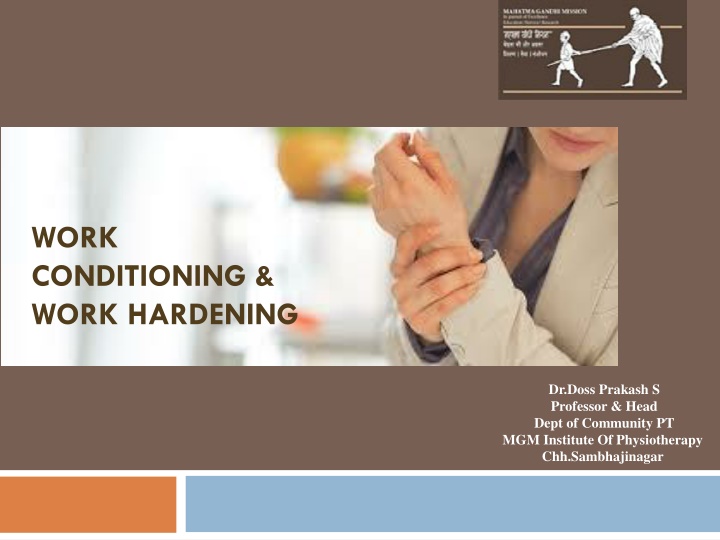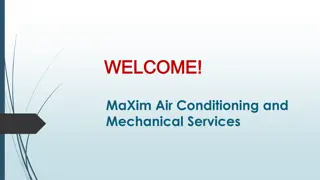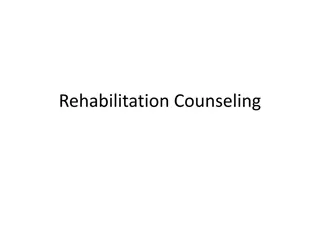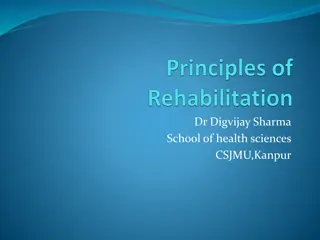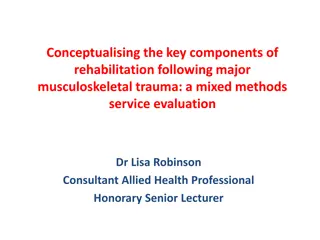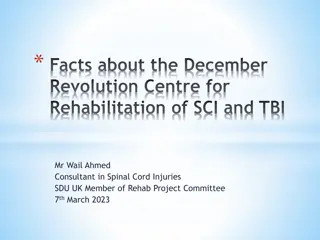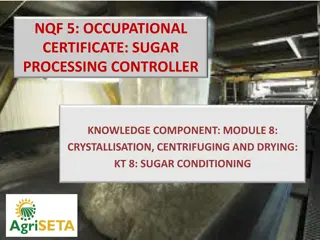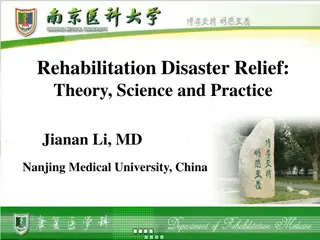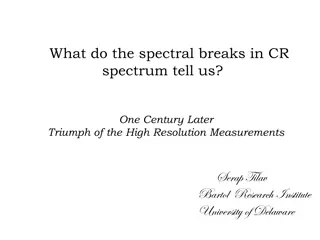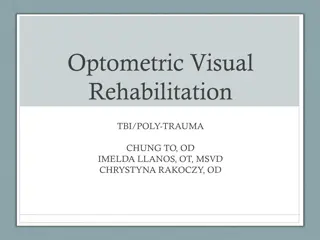Work Conditioning and Work Hardening for Successful Rehabilitation
High levels of therapeutic intervention designed to help patients regain enough function to return to work. These therapies are ideal for patients that have already progressed through traditional physical therapy but still lack full function in relation to specific duties required on the job. Work conditioning and work hardening utilize real or simulated work tasks to prepare patients for a safe transition back into the workforce while preventing new or worsened injuries.
Download Presentation

Please find below an Image/Link to download the presentation.
The content on the website is provided AS IS for your information and personal use only. It may not be sold, licensed, or shared on other websites without obtaining consent from the author.If you encounter any issues during the download, it is possible that the publisher has removed the file from their server.
You are allowed to download the files provided on this website for personal or commercial use, subject to the condition that they are used lawfully. All files are the property of their respective owners.
The content on the website is provided AS IS for your information and personal use only. It may not be sold, licensed, or shared on other websites without obtaining consent from the author.
E N D
Presentation Transcript
WORK CONDITIONING & WORK HARDENING Dr.Doss Prakash S Professor & Head Dept of Community PT MGM Institute Of Physiotherapy Chh.Sambhajinagar
The process Rehabilitation (Medical) Employee Treatment Injury
EMPLOYEE INJURED / DISABLED Forced to stay at home due to disability - HANDICAP RTW Shifted to some other department RTW Same department, decreased efficiency Take some other employment / business Philanthropy
Rehabilitation Institution Clinic Medical Home based Society / Community based Community
Another Dimension of Rehabilitation Medical Community Are we focusing on Employment Rehabilitation
Specific RTW requirements 1) Physical Capabilities - Strength, Endurance, Flexibility, Mobility 2) Self-management skills Pacing skills, coping skills, Employee / employer coordination, pain management, Work habits, confidence and motivation 3) Support structure Systemic approach, Preventive education, compensation, Honesty & Trust, Well defined goals 1 RTW 3 2
Work Conditioning Successful Rehabilitation to Employee RTW after injury / disability Work Hardening
Work conditioning & Work hardening High levels of therapeutic intervention designed to help patients regain enough function to return to work. These therapies are ideal for patients that have already progressed through traditional physical therapy but still lack full function in relation to specific duties required on the job. Work conditioning and work hardening utilize real or simulated work tasks to help prepare patients for a safe transition back into the work force while preventing new or worsened injuries.
Work Conditioning A rigorous conditioning program designed to help patients regain their systemic, neurological, cardiopulmonary and musculoskeletal functions. This includes strength, mobility, power, endurance, motor control and functional abilities. Work conditioning provides a middle step in the process of returning to work. The goals of a work conditioning program are to restore the patient s physical capacity and functional abilities, to prevent the recurrence of the same injury, and to decrease their fear of returning to work.
Work hardening An individualized, highly-structured program designed to help patients return to their pre-injury work level in a safe and timely manner. It aims to help patients regain their biomechanical, cardiovascular, metabolic, neuromuscular and psychosocial functions in conjunction with their work tasks. Work hardening is multidisciplinary, using a physical therapist, occupational therapist, psychologist and vocational specialist. Strengthening and flexibility exercises, cardiovascular conditioning, spine and joint stabilization exercises and job task training (i.e. pushing, pulling, crouching, lifting, bending, sitting, or twisting).
Differences Work Conditioning Work Hardening Rigorous conditioning program Individualized, highly-structured program Help patients regain their systemic, neurological, cardiopulmonary and musculoskeletal functions Help patients return to their pre-injury work level in a safe and timely manner Improvements in strength, mobility, power, endurance, motor control and functional abilities Regain their biomechanical, cardiovascular, metabolic, neuromuscular and psychosocial functions in conjunction with their work tasks Middle step in the process of returning to work multidisciplinary, using a physical therapist, occupational therapist, psychologist and vocational specialist Restore the patient s physical capacity and functional abilities Strengthening and flexibility exercises, cardiovascular conditioning, spine and joint stabilization exercises and job task training (i.e. pushing, pulling, crouching, lifting, bending, sitting, or twisting
Session Work conditioning Work hardening 4 to 8-week functional programs 1-3 hours for 2-3 days per week 2-4 hours for 3-5 days per week Each program is individualized to treat the patient s specific injury and dependent on what the treating physician prescribes. The time and length of the sessions can usually be tailored around the patients work schedule.
Functional Baseline Assessment At the first visit, a therapist will evaluate the injury and review the patients needs in relation to their job. To determine the patient s functional baseline, the therapist will need to: 1. Determine the patient s current physical activeness (sedentary, light, medium or heavy). 2. Determine the patient s aerobic capacity (poor, fair, average, good or excellent). 3. Determine the patient s grip strength. 4. Determine the patient s mobility, core and joint specific strengths in relation to their injury.
Key Directives Simulation of the critical work demands Strength and endurance Education Assessment Evaluation
In summary, the goal of work / functional conditioning is to restore an individual s physical, functional, and vocational skills in preparation for returning to the productive work force. Patients who require a major comprehensive approach to return to work, require more direction and individualized care, present with attitudinal, behavioral, or significant chronic pain that would interfere with return to work are appropriate for work hardening.
The goal of work hardening is to restore an individuals physical, functional, behavioral, psychosocial, and vocational skills in preparation for returning to the productive work force. This process serves to benefit the patient, healthcare staff treating the patient, and payers. A majority of patients will be effectively served with conventional rehabilitation and, as research suggests, return to work within the first six months. Those requiring further rehabilitation would require a more comprehensive program of work / functional conditioning or work hardening.
The ultimate goal is return the worker back to the productive workforce with timely rehabilitation
